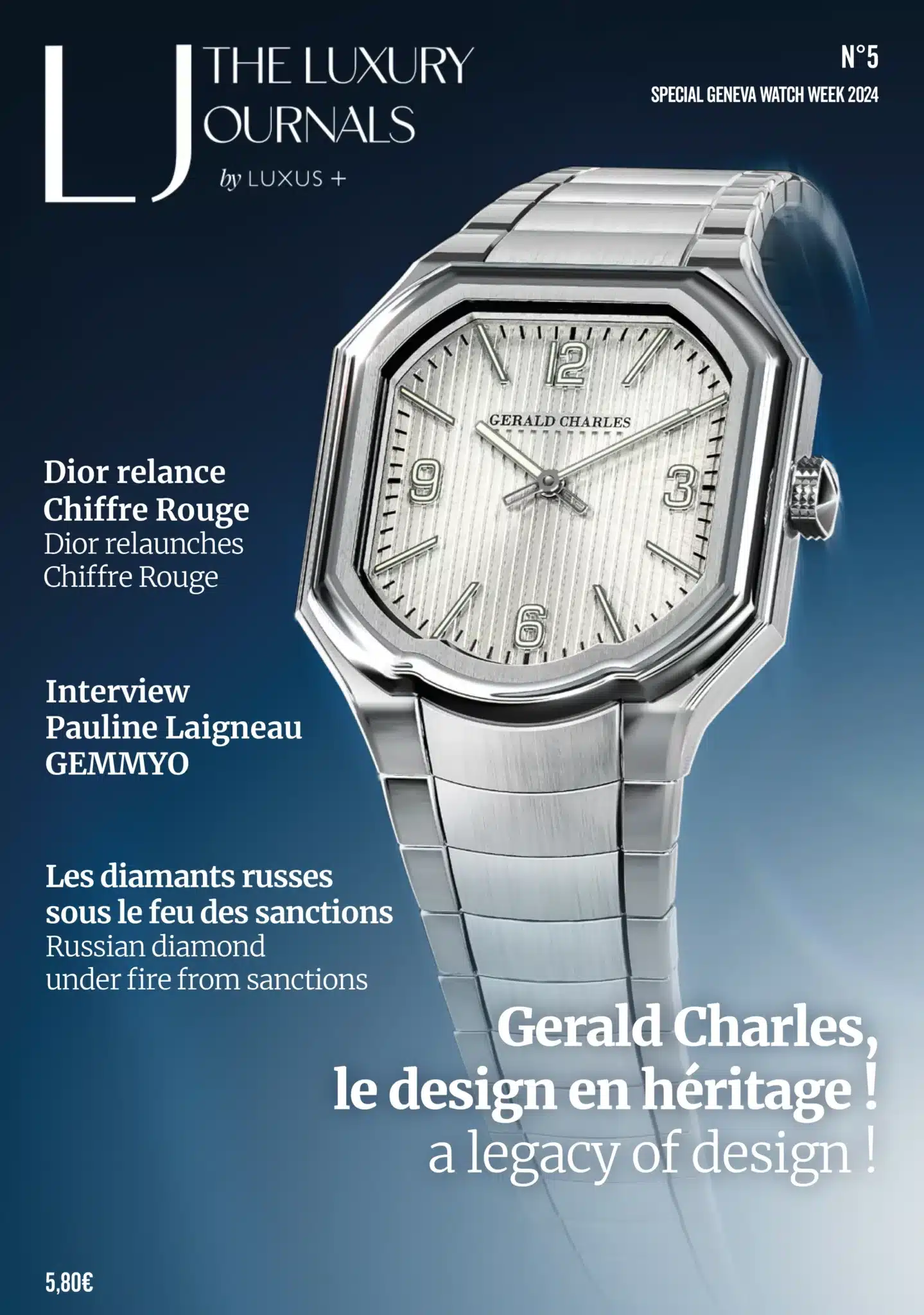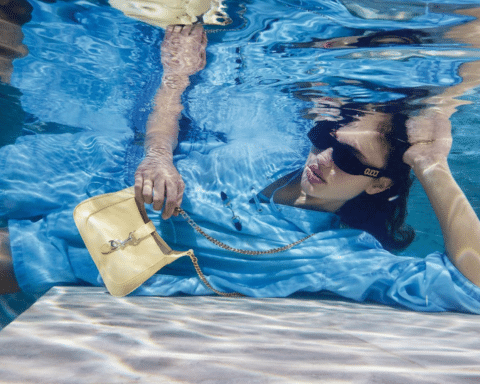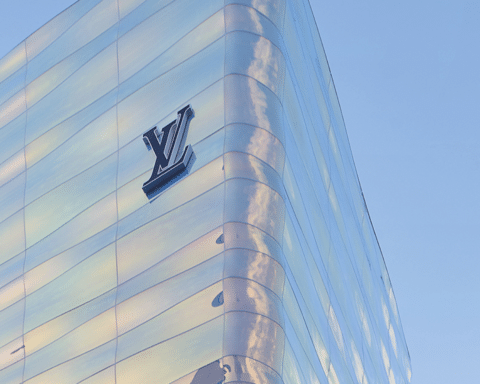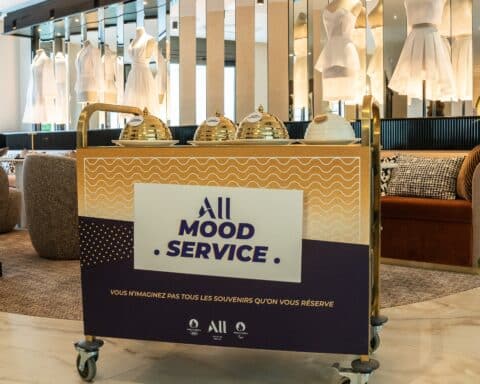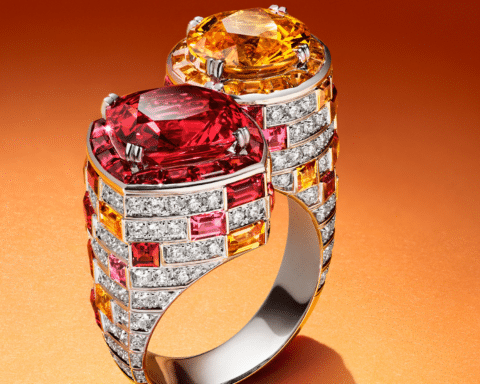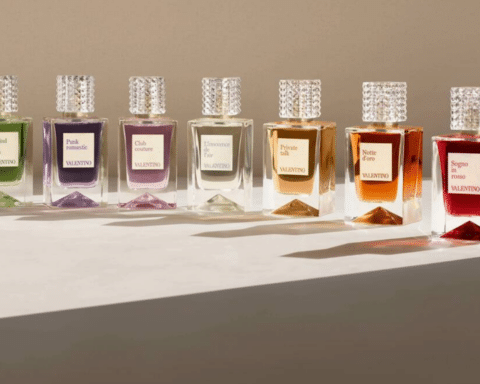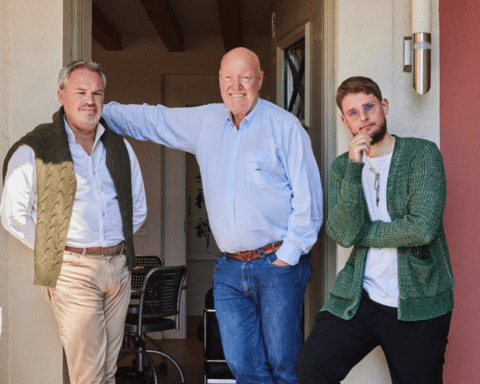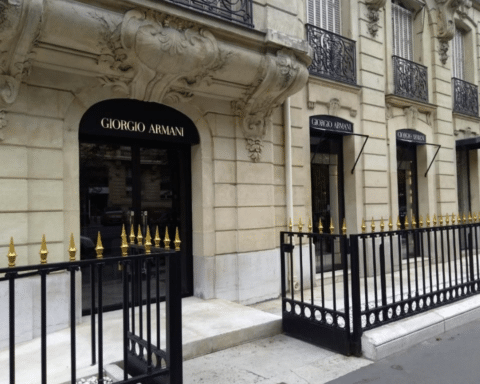[vc_row njt-role=”people-in-the-roles” njt-role-user-roles=”administrator,editor,author,armember”][vc_column][vc_column_text]
Renamed The Landmark under the LVMH pavilion, the jewelry brand’s iconic 1940 flagship – inseparable from Blake Edward’s film masterpiece starring Audrey Hepburn – reopened on April 28. After four years of intensive work under the direction of Peter Marino, the showcase offers a privileged experience in many ways.
Ten ultra-luxury floors
“How Do I Look? Very Good, I must say I’m amazed!” These few lines of dialogue between Holly Golightly and Paul Varjak – alias Audrey Hepburn and George Peppard – in Blake Edward’s 1961 film Breakfast at Tiffany’s (Diamonds on the Sofa) could sum up the impression one gets when faced with the work done by the LVMH group to modernize this symbolic address of the “Big Apple” jeweler—a total of 110,000 square meters on ten floors at 727 Fifth Avenue.
For its first major renovation since it opened 83 years ago, the Tiffany & Co store, renamed The Landmark, LVMH has put in place the means to restore the splendor of what the group does not hesitate to call “the jewel in the crown of New York.”

Rumor has it that these titanic works – launched in spring 2019 and whose delivery has been delayed by the pandemic – are the most significant investment made in a single store in the history of the LVMH group.
However, the amount committed has not been revealed. However, financial analysts estimate the renovation at around 500 million euros. Refusing to confirm the operation amount, the group’s president Bernard Arnault retorted: “You can’t dream when talking about numbers. When you create desire, profits are only the consequence.”
The offbeat redevelopment was launched in 2018 by Tiffany & Co’s former management team before coming under the LVMH group’s supervision since the jewelry house’s acquisition in 2021 for $15.8 billion.
The LVMH group then entrusted the realization to two giants of architecture. First, there was Peter Marino, a renowned interior architect, and collector known for having conceptualized and refurbished many of the group’s flagships, including the famous Dior 30 Montaigne. The latter was responsible for renovating the interior design of the store.
He was assisted in his task by OMA New York. This architectural firm, founded by Rem Koolhaas – responsible for renovating the Plaza Athénée in Paris – has commissioned Japanese architect Shohei Shigematsu to redo the core of the building as the technical infrastructure.
Initially scheduled for delivery in the fourth quarter of 2021, its opening has been postponed due to the shutdown of non-essential construction sites amid the pandemic.

According to the brand, the result is an immersive interior that gives access to a “new wonderful world.”
The customer is first welcomed on the second floor by a wall of videos that look like large windows. They intermittently show views of Central Park or the Manhattan skyline. These screens can also be deactivated to become simple double mirrors.
On the ceiling, the visitor can contemplate a 22-meter work, “Diamond Skylight,” created by Hugh Hutton, a tribute to Tiffany’s reputation as a supplier of the world’s finest diamonds. The parquet floor is reminiscent of the building’s original 1940s layout. The most fashionable Tiffany collections, such as Tiffany Lock and Tiffany T, are displayed in this space.
The third floor – decorated with ivory silk wall panels reminiscent of wedding dresses – is dedicated to Tiffany & Co’s flagship product: engagement rings. A spiral staircase, inspired by Elsa Peretti – the company’s former artistic director – with transparent balustrades enhanced with crystal stones, leads up to the other floors of the boutique, up to the eighth. A revisited version of the famous mythological statue of Atlas supporting the clock by Henry Frederick Metzler (1853) – visible on the building’s façade – towers over the base of the staircase. For the less athletic, an elevator system also serves all store floors.
Clients wishing to discover the silver, art de vivre, and fine jewelry collections should go to the 5th, 6th, and 7th floors, respectively.

The famous Blue Box Café and restaurant – inaugurated by Tiffany in a pop-up store version in 2017 and then exported to London at Harrods during the works – has returned to its original location but this time with Michelin-starred chef Daniel Boulud. Refurbished, it now has a private dining room and a bar with an art installation.
As for the rest, nearly 40 works of art never before on display to the public are spread throughout the store. Among the artists on display: are Damien Hirst, Julian Schnabel, Rashid Johnson, Anna Weyant, and Daniel Arsham.
While access to the store is free, all requests for services related to the product (engraving, embossing, repair, cleaning, or personal shopping) are made exclusively by appointment. These can be made with sales consultants in the boutique or by video.
A diamond on the roof
But the show’s highlight is undoubtedly the 29-meter-high glass cube covering the top three floors of the building, a work by Shohei Shigematsu of the architecture firm OMA New York. Contrasting with its limestone and granite facade, the modern structure – which replaces the offices installed in the 1980s – blends into the New York setting, offering a breathtaking panoramic view.

When LVMH bought the Maison Tiffany, the renovation project initiated in 2018 by Alessandro Bogliolo, general manager at the time, and designer Reed Krakoff already included the new framework that tops the building. At the time, the plan was to demolish the top three floors’ limestone elevation to build a new three-story structure and the current glass cube.
However, LVMH replaced the management team and appointed Anthony Ledru as its head. The group then also called on Peter Marino to handle the interior redesign.

The eighth and ninth floors house a museum and exhibition space. Eventually, The Landmark will house the world’s largest exhibition of fine jewelry. It will be possible to see the new design of the legendary 128.54-carat Tiffany diamond.
The space also houses the “Audrey Hepburn experience.” An exhibition dedicated to the heroine of the film Breakfast at Tiffany’s a joyful night owl and model of an emancipated woman from her native South. In addition to images of the filming, a replica of the Givenchy dress worn by the actress in the film and her famous pearl necklace can be seen.
Tiffany’s current president and CEO, Anthony Ledru, insists that this is more than just a jewelry store: “a true cultural center offering refined architecture, unique hospitality, and cutting-edge art and design.”
Finally, the top floor houses a 700 square meter VIP suite, making it a spacious apartment with multiple spaces, for which Peter Marino had carte blanche. It features a dining room, a lounge with a view of Central Park, a bar, and a library containing the House’s archives.
A strategic location
Located at the intersection of 57th and Fifth Avenues, Tiffany’s flagship store is undoubtedly one of the most famous retail addresses in the world. Before its closure for renovation, the store was known to generate 10% of the company’s sales.
The renovation of The Landmark is part of an effort to revitalize the neighborhood that stretches from 49th Street to the Plaza Hotel and includes Fourth and Fifth Avenues. The area has long been home to luxury department stores such as Saks Fifth Avenue and Bergdorf Goodman.
After serial closures in the neighborhood in 2017 due to the rise of e-commerce and excessive real estate leases, luxury brands have returned.
Department store Saks spent nearly $250 million to renovate its flagship store, including a revamped men’s department. Hermès opened a four-story flagship on nearby Madison Avenue in 2022. Retail concepts have been refreshed to attract tourists again as the pandemic has subsided.
This new appeal for the neighborhood is also due to declining commercial rents. While Bulgari spent 5,000 euros per square meter for its flagship in 2015, rents have dropped by 2,000 for first-floor spaces.
In acquiring jeweler Tiffany & Co, LVMH had the ambition to make a luxury move far beyond its reputation for engagement rings. The luxury group sought to awaken the “sleeping beauty” through lines and campaigns tailored to younger generations, such as #AboutLove with singers Jay Z and Beyoncé.
According to HSBC analysts, the New York-based jeweler has already seen its sales rise from €3 billion in 2020 to €5.1 billion in 2022 and is expected to reach €7.4 billion in 2025.
The LVMH group – the leader in international luxury and the most valued European company in the world – has also invested heavily in the flagships of other of its Houses, such as Bulgari opposite Tiffany or Louis Vuitton Place Vendôme in Paris.
“The reopening of Tiffany is the latest round of high-profile investment in the neighborhood,” said Richard Hados, vice president of the New York retail team at real estate firm JLL. Meanwhile, Rolex is renovating its Fifth Avenue headquarters, which will include a ground-floor boutique and a 25-story glass office tower.
An inaugural capsule collection
To encourage customers to visit its flagship, Tiffany offered a range of exclusive models and unique creations designed especially for its reopening. These include diamond watches, decorative objects for the home, and eyewear.
At five o’clock in the morning, with a low-angled light reflecting off the tall glass buildings, a shadowy, elegantly gloved, and bejeweled figure walks down the avenue in a little black sheath dress, holding a croissant and a cup of coffee in her hands.

Suddenly, as if ecstatic, she can’t stop staring at a store window. This figure is none other than Holly Golightly – played by Audrey Hepburn – the heroine of the film Breakfast at Tiffany’s, adapted from the novel of the same name by Truman Capote. The Landmark, this address linked to a monument of the cinema, is once again in the spotlight…
Read also > Tiffany’s: the mythical store on 5th Avenue in New York reopens its doors!
Featured photo : © Tiffany & Co[/vc_column_text][/vc_column][/vc_row][vc_row njt-role=”not-logged-in”][vc_column][vc_column_text]
Renamed The Landmark under the LVMH pavilion, the jewelry brand’s iconic 1940 flagship – inseparable from Blake Edward’s film masterpiece starring Audrey Hepburn – reopened on April 28. After four years of intensive work under the direction of Peter Marino, the showcase offers a privileged experience in many ways.
Ten ultra-luxury floors
“How Do I Look? Very Good, I must say I’m amazed!” These few lines of dialogue between Holly Golightly and Paul Varjak – alias Audrey Hepburn and George Peppard – in Blake Edward’s 1961 film Breakfast at Tiffany’s (Diamonds on the Sofa) could sum up the impression one gets when faced with the work done by the LVMH group to modernize this symbolic address of the “Big Apple” jeweler—a total of 110,000 square meters on ten floors at 727 Fifth Avenue.
For its first major renovation since it opened 83 years ago, the Tiffany & Co store, renamed The Landmark, LVMH has put in place the means to restore the splendor of what the group does not hesitate to call “the jewel in the crown of New York.”

Rumor has it that these titanic works – launched in spring 2019 and whose delivery has been delayed by the pandemic – are the most significant investment made in a single store in the history of the LVMH group.
However, the amount committed has not been revealed. However, financial analysts estimate the renovation at around 500 million euros. Refusing to confirm the operation amount, the group’s president Bernard Arnault retorted: “You can’t dream when talking about numbers. When you create desire, profits are only the consequence.”
The offbeat redevelopment was launched in 2018 by Tiffany & Co’s former management team before coming under the LVMH group’s supervision since the jewelry house’s acquisition in 2021 for $15.8 billion.
The LVMH group then entrusted the realization to two giants of architecture. First, there was Peter Marino, a renowned interior architect, and collector known for having conceptualized and refurbished many of the group’s flagships, including the famous Dior 30 Montaigne. The latter was responsible for renovating the interior design of the store.
He was assisted in his task by OMA New York. This architectural firm, founded by Rem Koolhaas – responsible for renovating the Plaza Athénée in Paris – has commissioned Japanese architect Shohei Shigematsu to redo the core of the building as the technical infrastructure.
Initially scheduled for delivery in the fourth quarter of 2021, its opening has been postponed due to the shutdown of non-essential construction sites amid the pandemic.

According to the brand, the result is an immersive interior that gives access to a “new wonderful world.”
The customer is first welcomed on the second floor by a wall of videos that look like large windows. They intermittently show views of Central Park or the Manhattan skyline. These screens can also be deactivated to become simple double mirrors.
On the ceiling, the visitor can contemplate a 22-meter work, “Diamond Skylight,” created by Hugh Hutton, a tribute to Tiffany’s reputation as a supplier of the world’s finest diamonds. The parquet floor is reminiscent of the building’s original 1940s layout. The most fashionable Tiffany collections, such as Tiffany Lock and Tiffany T, are displayed in this space.
The third floor – decorated with ivory silk wall panels reminiscent of wedding dresses – is dedicated to Tiffany & Co’s flagship product: engagement rings. A spiral staircase, inspired by Elsa Peretti – the company’s former artistic director – with transparent balustrades enhanced with crystal stones, leads up to the other floors of the boutique, up to the eighth. A revisited version of the famous mythological statue of Atlas supporting the clock by Henry Frederick Metzler (1853) – visible on the building’s façade – towers over the base of the staircase. For the less athletic, an elevator system also serves all store floors.
Clients wishing to discover the silver, art de vivre, and fine jewelry collections should go to the 5th, 6th, and 7th floors, respectively.

The famous Blue Box Café and restaurant – inaugurated by Tiffany in a pop-up store version in 2017 and then exported to London at Harrods during the works – has returned to its original location but this time with Michelin-starred chef Daniel Boulud. Refurbished, it now has a private dining room and a bar with an art installation.
[…][/vc_column_text][vc_cta h2=”This article is reserved for subscribers.” h2_font_container=”tag:h2|font_size:16|text_align:left” h2_use_theme_fonts=”yes” h4=”Subscribe now !” h4_font_container=”tag:h2|font_size:32|text_align:left|line_height:bas” h4_use_theme_fonts=”yes” txt_align=”center” color=”black” add_button=”right” btn_title=”I SUBSCRIBE !” btn_color=”danger” btn_size=”lg” btn_align=”center” use_custom_fonts_h2=”true” use_custom_fonts_h4=”true” btn_button_block=”true” btn_custom_onclick=”true” btn_link=”url:https%3A%2F%2Fluxus-plus.com%2Fen%2Fsubscriptions-and-newsletter-special-offer-valid-until-september-30-2020-2-2%2F”]Get unlimited access to all articles and live a new reading experience, preview contents, exclusive newsletters…
Already have an account ? Please log in.[/vc_cta][vc_column_text]Featured photo : © Tiffany & Co[/vc_column_text][/vc_column][/vc_row][vc_row njt-role=”people-in-the-roles” njt-role-user-roles=”subscriber,customer”][vc_column][vc_column_text]
Renamed The Landmark under the LVMH pavilion, the jewelry brand’s iconic 1940 flagship – inseparable from Blake Edward’s film masterpiece starring Audrey Hepburn – reopened on April 28. After four years of intensive work under the direction of Peter Marino, the showcase offers a privileged experience in many ways.
Ten ultra-luxury floors
“How Do I Look? Very Good, I must say I’m amazed!” These few lines of dialogue between Holly Golightly and Paul Varjak – alias Audrey Hepburn and George Peppard – in Blake Edward’s 1961 film Breakfast at Tiffany’s (Diamonds on the Sofa) could sum up the impression one gets when faced with the work done by the LVMH group to modernize this symbolic address of the “Big Apple” jeweler—a total of 110,000 square meters on ten floors at 727 Fifth Avenue.
For its first major renovation since it opened 83 years ago, the Tiffany & Co store, renamed The Landmark, LVMH has put in place the means to restore the splendor of what the group does not hesitate to call “the jewel in the crown of New York.”

Rumor has it that these titanic works – launched in spring 2019 and whose delivery has been delayed by the pandemic – are the most significant investment made in a single store in the history of the LVMH group.
However, the amount committed has not been revealed. However, financial analysts estimate the renovation at around 500 million euros. Refusing to confirm the operation amount, the group’s president Bernard Arnault retorted: “You can’t dream when talking about numbers. When you create desire, profits are only the consequence.”
The offbeat redevelopment was launched in 2018 by Tiffany & Co’s former management team before coming under the LVMH group’s supervision since the jewelry house’s acquisition in 2021 for $15.8 billion.
The LVMH group then entrusted the realization to two giants of architecture. First, there was Peter Marino, a renowned interior architect, and collector known for having conceptualized and refurbished many of the group’s flagships, including the famous Dior 30 Montaigne. The latter was responsible for renovating the interior design of the store.
He was assisted in his task by OMA New York. This architectural firm, founded by Rem Koolhaas – responsible for renovating the Plaza Athénée in Paris – has commissioned Japanese architect Shohei Shigematsu to redo the core of the building as the technical infrastructure.
Initially scheduled for delivery in the fourth quarter of 2021, its opening has been postponed due to the shutdown of non-essential construction sites amid the pandemic.

According to the brand, the result is an immersive interior that gives access to a “new wonderful world.”
The customer is first welcomed on the second floor by a wall of videos that look like large windows. They intermittently show views of Central Park or the Manhattan skyline. These screens can also be deactivated to become simple double mirrors.
On the ceiling, the visitor can contemplate a 22-meter work, “Diamond Skylight,” created by Hugh Hutton, a tribute to Tiffany’s reputation as a supplier of the world’s finest diamonds. The parquet floor is reminiscent of the building’s original 1940s layout. The most fashionable Tiffany collections, such as Tiffany Lock and Tiffany T, are displayed in this space.
The third floor – decorated with ivory silk wall panels reminiscent of wedding dresses – is dedicated to Tiffany & Co’s flagship product: engagement rings. A spiral staircase, inspired by Elsa Peretti – the company’s former artistic director – with transparent balustrades enhanced with crystal stones, leads up to the other floors of the boutique, up to the eighth. A revisited version of the famous mythological statue of Atlas supporting the clock by Henry Frederick Metzler (1853) – visible on the building’s façade – towers over the base of the staircase. For the less athletic, an elevator system also serves all store floors.
Clients wishing to discover the silver, art de vivre, and fine jewelry collections should go to the 5th, 6th, and 7th floors, respectively.

The famous Blue Box Café and restaurant – inaugurated by Tiffany in a pop-up store version in 2017 and then exported to London at Harrods during the works – has returned to its original location but this time with Michelin-starred chef Daniel Boulud. Refurbished, it now has a private dining room and a bar with an art installation.
[…][/vc_column_text][vc_cta h2=”This article is reserved for subscribers.” h2_font_container=”tag:h2|font_size:16|text_align:left” h2_use_theme_fonts=”yes” h4=”Subscribe now !” h4_font_container=”tag:h2|font_size:32|text_align:left|line_height:bas” h4_use_theme_fonts=”yes” txt_align=”center” color=”black” add_button=”right” btn_title=”I SUBSCRIBE !” btn_color=”danger” btn_size=”lg” btn_align=”center” use_custom_fonts_h2=”true” use_custom_fonts_h4=”true” btn_button_block=”true” btn_custom_onclick=”true” btn_link=”url:https%3A%2F%2Fluxus-plus.com%2Fen%2Fsubscriptions-and-newsletter-special-offer-valid-until-september-30-2020-2-2%2F”]Get unlimited access to all articles and live a new reading experience, preview contents, exclusive newsletters…
Already have an account ? Please log in.[/vc_cta][vc_column_text]Featured photo : © Tiffany & Co[/vc_column_text][/vc_column][/vc_row][vc_row njt-role=”people-in-the-roles” njt-role-user-roles=”subscriber,customer”][vc_column][vc_column_text]


